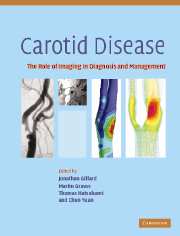Book contents
- Frontmatter
- Contents
- List of contributors
- List of abbreviations
- Introduction
- Background
- 1 Pathology of carotid artery atherosclerotic disease
- 2 Epidemiology of carotid artery atherosclerosis
- 3 Genetics of carotid atherosclerosis
- 4 Hematological processes in emboli formation
- 5 Medical treatment for carotid stenosis
- 6 Surgical management of symptomatic carotid disease: carotid endarterectomy and extracranial-intracranial bypass
- 7 Surgery for asymptomatic carotid stenosis
- 8 Interventional management of carotid disease
- Luminal imaging techniques
- Morphological plaque imaging
- Functional plaque imaging
- Plaque modelling
- Monitoring the local and distal effects of carotid interventions
- Monitoring pharmaceutical interventions
- Future directions in carotid plaque imaging
- Index
- References
3 - Genetics of carotid atherosclerosis
from Background
Published online by Cambridge University Press: 03 December 2009
- Frontmatter
- Contents
- List of contributors
- List of abbreviations
- Introduction
- Background
- 1 Pathology of carotid artery atherosclerotic disease
- 2 Epidemiology of carotid artery atherosclerosis
- 3 Genetics of carotid atherosclerosis
- 4 Hematological processes in emboli formation
- 5 Medical treatment for carotid stenosis
- 6 Surgical management of symptomatic carotid disease: carotid endarterectomy and extracranial-intracranial bypass
- 7 Surgery for asymptomatic carotid stenosis
- 8 Interventional management of carotid disease
- Luminal imaging techniques
- Morphological plaque imaging
- Functional plaque imaging
- Plaque modelling
- Monitoring the local and distal effects of carotid interventions
- Monitoring pharmaceutical interventions
- Future directions in carotid plaque imaging
- Index
- References
Summary
Introduction
Carotid atherosclerosis is a multifactorial phenotype that is the end product of an array of genetic and environmental causes. The number of cell types and factors that influence the interaction of inflammatory, metabolic and hemodynamic mechanisms is likely to be large. Each of these processes may have both “public” and “private” genetic determinants. Increasing knowledge of genes, their sequence variation, and their expression has provided novel insights regarding the contribution of individual genetic factors to atherosclerosis risk and potential biological pathways that mediate that risk.
Human genetic research has a recent history, starting from Mendel's reading of his paper, “Experiments on Plant Hybridization,” in 1865 and publication in 1866. Mapping and identification of genes for human traits require three essential ingredients – a heritable trait, biological material (DNA), and DNA polymorphisms. DNA polymorphisms are heritable markers that can be scored in human populations. Many of the early investigations in human genetics were restricted to Mendelian (single gene) disorders in families that exhibited either dominant or recessive inheritance patterns. The DNA polymorphisms were restricted to blood group or serological markers, and were relatively infrequent in the human genome. Human genetic studies were revolutionized by the development of a new class of markers (restriction fragment length polymorphisms, RFLPs) and an analytic framework to enhance gene discovery (Botstein et al., 1980).
Keywords
- Type
- Chapter
- Information
- Carotid DiseaseThe Role of Imaging in Diagnosis and Management, pp. 35 - 44Publisher: Cambridge University PressPrint publication year: 2006

